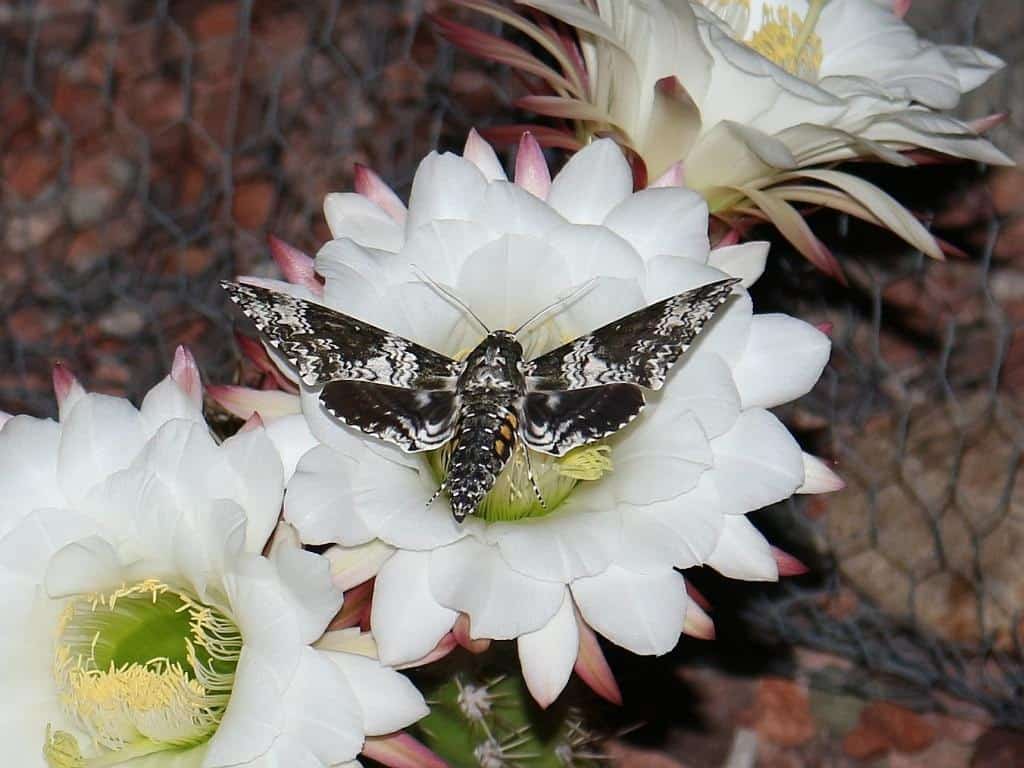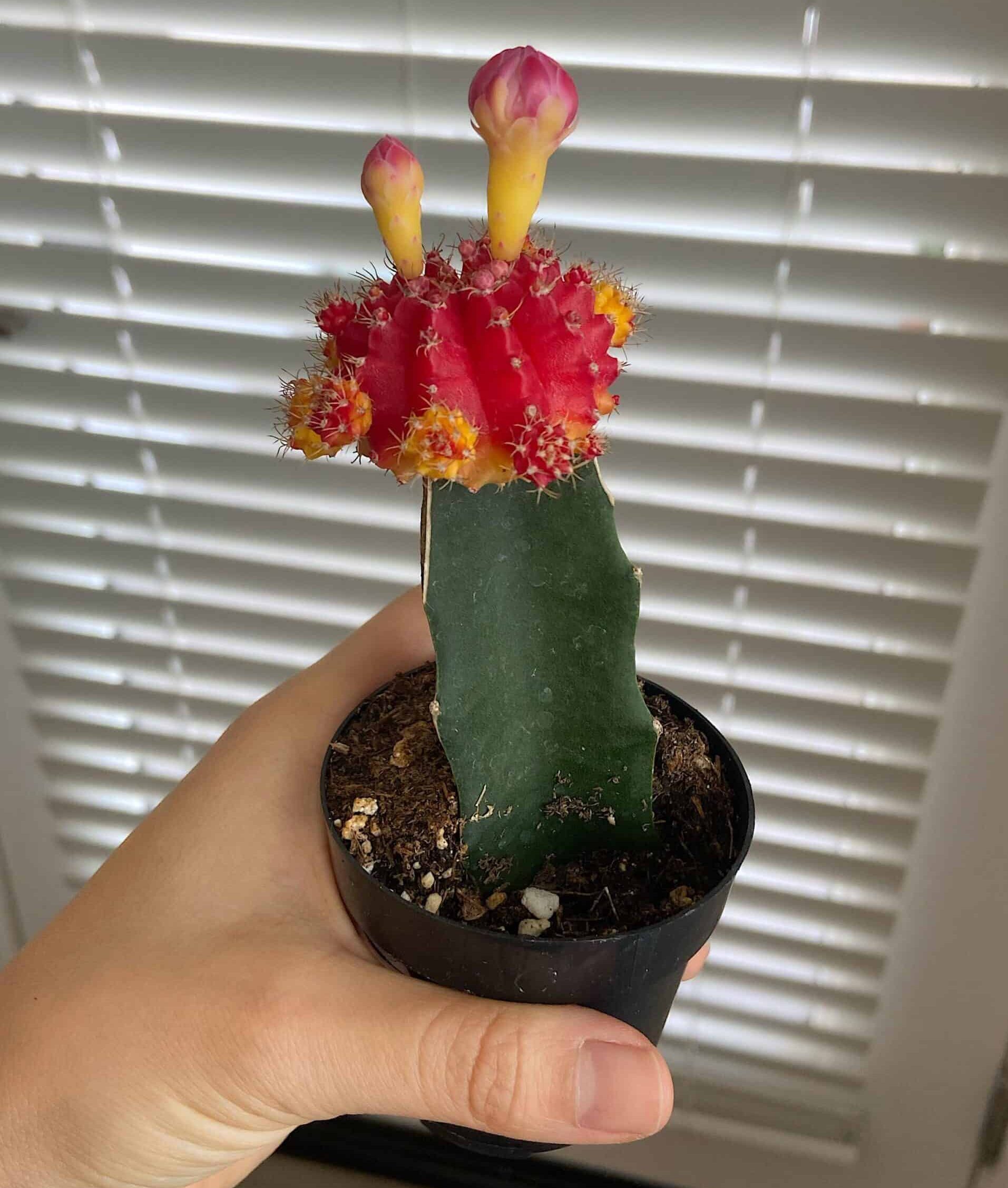Although the scions (colorful upper part of the cactus) are the beautiful part of the Moon Cactus, the flower is not far behind.
Its beautiful foliage, or should we say, its scion is the part that will grab your attention—the scion act as the base for the flower’s growth.
The Moon Cactus bloom needs certain conditions and environments to bloom. Let’s explore them in detail.
Table of Contents Show
How Often Does the Moon Cactus Bloom?
Although a beautiful plant, Moon Cactus cannot grow without grafting as it needs a host to survive.
You may be better at blooming if you keep your Moon Cactus outdoors. With the fulfillment of the requirements, they may bloom indoors.
However, grafted Cactus need to mature to be able to flower. While the maturity depends upon the rootstock, let your plant be at least an inch wide to let it bloom.

And when the rootstock flowers, the scion fails to give colorful blooms.
Moreover, you can drop the idea of not letting the plant flower as the Moon Cactus is not monocarpic, meaning the plant will not die after flowering.
After it blooms, you may have to wait a year or two before the plant flowers.
Moon Cactus Blooms Overview
Generally, the Moon Cacti plant represents resilience as it survives on top of another plant.
People also perceive Moon Cacti as tenacity, endurance, and strength symbol.
| Factors | Specifications |
|---|---|
| Flower size | Up to 4 inches wide |
| Flower Shape | Slender, funnel-shaped |
| Flower Petals | Spread out ~10 petals |
| Flower Color | White, pink or yellow |
| Fragrance | No fragrance |
| Flower characteristics | Showy flowers that emerges on top of spines |
| Blooming Season | Spring (April to May) |
| Flower span | 12 hours |
| Toxicity | Non-toxic to animals and humans |
The color of flowers is usually the same as the plant’s scion, with the plant capable of producing blooms with multiple colors like yellow-red, yellow-orange, etc.
Pollination of Colorful Moon Cactus Blooms
One of the best ways to propagate is via seed propagation.
To produce seeds, you must let the plant go through pollination first. The plant can propagate via the following two methods.
1. Natural Pollination
In Moon Cacti, pollination is usually done by moths and bats when the plant blooms at night.

If you are lucky, the pollinators will collect the pollen and deposit it to the Stigma of the same or another plant within the same night.
As the flower has a shorter lifespan, the anther and stigma may be active simultaneously to aid in pollination.
Meanwhile, the prospect of wind pollination depends on various factors, like the amount of wind, direction, and the structure of the flower, which is unlikely as the Moon Cacti is funnel-shaped.
Leaving the pollination duties to insects and birds can deny you any success as the blooms are short-lived.
2. Hand Pollination
Manual pollination is hard to perform for Moon Cactus rarely produces seeds due to the lack of chlorophyll.
While it may be a long and complex process, pollinating the plant by hand will give you a fair shot at success.
Follow the steps below properly to ensure safe and efficient pollination.
- Use a utility knife to cut the whorls of sepals and petals off the plant to reveal the Stigma.
While removing the sepals and petals, ensure you do not cut the stamen, or the pollination will not occur.
- Take a chopstick and unfurl the tiny Stigma very carefully.
- Now take the whorl you separated earlier and look for the anthers.
- Rub your chopstick on the pollen you find and rub the pollen-laden chopstick on the Stigma.
- Repeat the above process several times to increase the chance of success.
If the buds do not fall off and start growing in 2-3 days, congratulations, you were successful.
After nearly a month, you can harvest the seeds and propagate them.
How to Make a Moon Cactus Plant Flower?
Here comes the hard part: you must be attentive to the plant’s needs if you want to make this flower.
An anomaly in fulfilling its requirement can hamper the plant’s ability to flower. And you may even never see the plant flower ever.
- Plants in the cacti genera usually need a dormancy period to bloom. So, keep the plant at a temperature of around 60°F for 3-4 months to force a bloom.
- Relocate the plant to a cool place with bright enough but not direct sunlight and cut back on watering or fertilizing. This plant is susceptible to root rot.
- Use a pot with well-functioning drainage holes for these Hibotan Cacti and place it in bright light.
- Make sure the rootstock cactus gets enough sunlight so that it will be able to convert the energy to produce flowers.
- Moon Cacti prefer low-humidity conditions. So, you can place them indoors to provide the required humidity.
- You need to use well-draining soil with added perlite or coarse sand. A commercial potting cactus mix is also good for Star Flowered Cactus.
- Placing the plant in a south-facing window with a few hours of morning sunlight is pivotal in making the plant flower.
- You can use a phosphorus-rich fertilizer for your Cactus to encourage the bloom.
Common Problems with Moon Cactus Blooms
The flower may show some problems despite having a short lifespan of only 12 hours and being sturdy. Most of the issues are associated with unsuccessful pollination.
Let’s look at some of the common problems and their causes.
- If the Moon Cactus plants cannot drain the excess water in the soil, the flower may wilt a few hours after opening.
- Root rot and overwatering can lead the Cactus flowers to turn brown, rot, and even die in a worst-case scenario.
- Excess humidity enhanced pest invasion in the plant.
- Lack of light and extreme temperature can cause the flower to drop petals off.
- If the top part of the flower doesn’t have regular airflow, the scion may rot and die.
- Sometimes you may encounter grafted Cactus flowers falling off. That may be due to the dryness of the soil.
Many people confuse the scion for the flowers. At times when the scion falls off the Moon Cactus rootstock, the rootstock produces vertical arms on it.
What Should you do with Moon Cactus Plants Flower?
The beauty of the flowers pales compared to the beauty of the scion.
You could use them for decoration but lacks a longer lifespan.

Further, the rot will transfer to the plant, killing it for good.
It would be best not to cut the flowers because they give a pretty good look to the plant overall.
How to Cut the Moon Cactus Blooms?
After the flowers are spent, and on the verge of dying, you can cut them off to protect the energy and the plant.
Generally, grafted Moon Cactus flowers are easily detachable. So you may not need tools to perform the cutting.
But careful! Wear protective gardening gloves to prevent yourself from the “ouch” before embarking on the process.
Gently grab the flower by its base and twist it carefully to remove the blooms.
Since the Cactus flowers don’t have any particular medicinal or culinary uses, dispose of them.
Health Considerations to Keep in Mind
As a hybrid mutant, Moon Cactus is a rare plant that people always sell after grafting them to another plant’s rootstock.
Whenever you think of cacti, you may know how dangerous, toxic, and poisonous they must be. But you are mistaken here.
As the plant is non-toxic, there is no evidence of the Moon Cactus blooms being toxic. So, you can deem the flowers not to hurt anyone.
That said, you need to be careful about its thorns, so sharp they can pierce and puncture your skin. Your curious pets can be seriously injured when they attempt to nibble on the plant.
So, the only thing you need to do to be safer is to wear gloves to handle the cactus and keep it out of the reach of your kids and pets.
From Editorial Team
Conclusion!
The rootstock, the grafted scion, and the flowers, all three portions of a Moon Cactus, add to the beauty of the plant.
You should get a grafted Cactus if you are up for growing a flower. If your moon cactus is distressed, you must know they “needle little love.”
Good luck!
